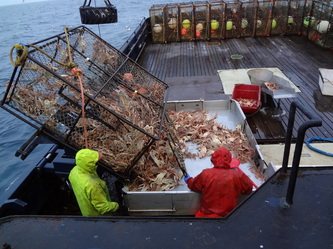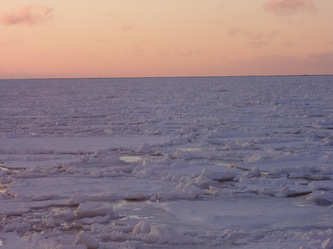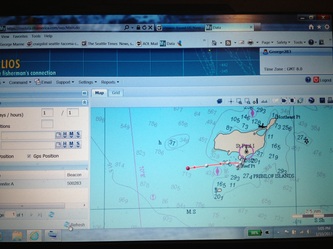Ok, my bad....I should have posted the first part of this update last week, but where the heck does the time go?!
Last Friday, Brenna and I were out doing a little retail therapy, and my cell phone rings. The name showing, "F/V Brenna A!"
It was Sean calling from the beautiful Priblof Island of St. Paul! The connection was a clear as a bell, and Sean says, "Hi Mom, we are in offloading." It was great to talk to him. They had survived their first week of setting the crab pots, checking them, emptying them, and throwing those lovely little dollar bills, oops, I mean Opilio crab, in the the fish tanks. He was kind of sore, lots of muscles being used heaving everything around, but it was a good kind of pain!
I asked him how everything going, especially the weather. He said everything was going great, and that the weather had been "fine." I said, "What do you mean by fine?" He replied back, "Well, it's been great. We've had really calm seas, no rain, no snow, and in fact, the Bering Sea has been as flat and glassy as a pond, the sun has even been out." I paused, and said, "ok, I can handle it, really how has it been?" Again he said, "flat and glassy calm Mom" I wanted to jump up and down and scream "Yippee!" but being in a crowded shoe section at Macy's I though better of it so as not to embarrass my daughter.
So, Sean's first week crab fishing in the Bering Sea in the middle of winter, was great. So Crabby Mama was Happy Mama!
I asked him about life on the boat and how it was going as far a being the new guy on the crab deck. He said everything was great. He's learning lots and the crew was getting their rhythm and pace set. He said the one thing that they do on the Jennifer A, is rotate the different positions on the deck, so no one person is doing the say job over and over. I think that's pretty cool and actually pretty smart...that way, if someone needs a break, and can't be out on deck, anyone can step into that position. Plus, it helps cut down on some of the repetitiveness, which can help cut down on injuries. Again, Happy Mama!
They get up every day around 5am, have breakfast and then are out on the deck by 5:30am. He said they fish until about 11pm, have something to eat and then crash in their bunks. From about 11:30pm until 5am, while they are sleeping, the boat is "drifting." Drifting means just that. It's just drifting around the Bering Sea. No one is steering it. The are about a billion various alarms set, so if something gets to close or something happens in the engine room, very LOUD alarms go off. It's all good!
The crab fishing has been pretty good. The boat is averaging about 300 crab per pot, which is pretty good. It took them a couple days to find the crab and get on them, but once they did, it was full pots away! Yep. Happy Mama!
They pulled into St. Paul to offload and started around 5:30am. When I talked to Sean at a 11:30am Seattle time they were just pulling away from the dock, having finished with their unloading. Soooo, how do you unload a big ole tank full of live crab? Well, you send the unloading crew from Trident Seafoods down into the fish hold, and have them start unloading, by hand. This involves about 10 guys, pretty much standing in the tank, on top of the crab, and they unloading crew starts grabbing the live crab, into a big net called a broiler bag. Once the brailer bag is full, they are raised up by a crane and go inside the plant to be processed. There is a scale on the bag so the weight of each bag can be recorded.
Because the crab have to be kept have to be kept alive from the time they are caught, until the time they are delivered, they are held in a fish tank that is kept full of fresh sea water. The crab tanks on our boat are about the size of a two car garage. When the tanks are full, they are stuffed to the brim with crab. Sea water is pumped in through a series of pipes so as to keep the crab alive. Crab need to be kept alive from the time they are caught from the time they are delivered. From the time the first crab is caught until the time the last crab is delivered, that time span can be up to a week, or 10 day. The processors buying the crab try to minimize that time, by setting up a schedule and have boats deliver on a regular basis. The trick is to try and get the crab out of the pots and into the crab tank as fast as possible. If not, and the weather is cold, they turn into "hockey pucks," a crab with no legs. Inside the crab tanks is circulating sea water. The water is flushed from the ocean to the tank continuously so the crab can stay alive in their new home, on the way to your home
Once the crab leave the boat they head into the processing plant. There they are butchered, (cut in half) cooked, and then frozen. Once completely frozen they are boxed up and shipped off to become part of your dining pleasure.
So here is your fun fact for the day...my friend Joel asked how deep of water do we set the crab pots. The Jennifer A fishes in an average water depth of about 350 feet of water. If you look at the map and see alllll that blue water, isn't it amazing that in some parts of the ocean, that far away from land, you can be in such shallow water?! It always amazed me when Pat and I were on the boat, (years ago!) and we were traveling up to Bristol bay...you could be 1-2 miles offshore and only have 60 feet of water under you. While I was always amazed, Pat was even more amazed with my amazement...he'd be like, "the bottom of the ocean is like the land, you have hills, valleys, mountains, high spots and low spots. I was like, "I know that, but we are out in the middle of the huge Bering Sea...there should be more than 60 feet of water under us!" Obviously, it still amazes me to this day! Like I said, fun fact...or maybe not!
Just got a text from Sean, and they have offloaded their second load in St. Paul and are headed back out to the grounds. The crab are still crawling into the pots, and their crab per pot average was a little higher this time and had some pots that had 500-600 crab in it! The weather this trip out was a little, "sloppy." It wasn't to bad he said, wind gusts up to about 40 mph, and kinda rolly and lumpy most of the time...but he assured me it wasn't the kind of lumping that knocks you down or makes the crab pots swing like crazy. Whew, thanks Bud...I think...let's just call me kinda Crabby Mama!
More pictures below, again from last year as Sean wasn't able to send any pictures from this year yet. Hopefully you can get an idea of the tanks full of crab, and the offloading process.
More later, thanks for reading along!
Last Friday, Brenna and I were out doing a little retail therapy, and my cell phone rings. The name showing, "F/V Brenna A!"
It was Sean calling from the beautiful Priblof Island of St. Paul! The connection was a clear as a bell, and Sean says, "Hi Mom, we are in offloading." It was great to talk to him. They had survived their first week of setting the crab pots, checking them, emptying them, and throwing those lovely little dollar bills, oops, I mean Opilio crab, in the the fish tanks. He was kind of sore, lots of muscles being used heaving everything around, but it was a good kind of pain!
I asked him how everything going, especially the weather. He said everything was going great, and that the weather had been "fine." I said, "What do you mean by fine?" He replied back, "Well, it's been great. We've had really calm seas, no rain, no snow, and in fact, the Bering Sea has been as flat and glassy as a pond, the sun has even been out." I paused, and said, "ok, I can handle it, really how has it been?" Again he said, "flat and glassy calm Mom" I wanted to jump up and down and scream "Yippee!" but being in a crowded shoe section at Macy's I though better of it so as not to embarrass my daughter.
So, Sean's first week crab fishing in the Bering Sea in the middle of winter, was great. So Crabby Mama was Happy Mama!
I asked him about life on the boat and how it was going as far a being the new guy on the crab deck. He said everything was great. He's learning lots and the crew was getting their rhythm and pace set. He said the one thing that they do on the Jennifer A, is rotate the different positions on the deck, so no one person is doing the say job over and over. I think that's pretty cool and actually pretty smart...that way, if someone needs a break, and can't be out on deck, anyone can step into that position. Plus, it helps cut down on some of the repetitiveness, which can help cut down on injuries. Again, Happy Mama!
They get up every day around 5am, have breakfast and then are out on the deck by 5:30am. He said they fish until about 11pm, have something to eat and then crash in their bunks. From about 11:30pm until 5am, while they are sleeping, the boat is "drifting." Drifting means just that. It's just drifting around the Bering Sea. No one is steering it. The are about a billion various alarms set, so if something gets to close or something happens in the engine room, very LOUD alarms go off. It's all good!
The crab fishing has been pretty good. The boat is averaging about 300 crab per pot, which is pretty good. It took them a couple days to find the crab and get on them, but once they did, it was full pots away! Yep. Happy Mama!
They pulled into St. Paul to offload and started around 5:30am. When I talked to Sean at a 11:30am Seattle time they were just pulling away from the dock, having finished with their unloading. Soooo, how do you unload a big ole tank full of live crab? Well, you send the unloading crew from Trident Seafoods down into the fish hold, and have them start unloading, by hand. This involves about 10 guys, pretty much standing in the tank, on top of the crab, and they unloading crew starts grabbing the live crab, into a big net called a broiler bag. Once the brailer bag is full, they are raised up by a crane and go inside the plant to be processed. There is a scale on the bag so the weight of each bag can be recorded.
Because the crab have to be kept have to be kept alive from the time they are caught, until the time they are delivered, they are held in a fish tank that is kept full of fresh sea water. The crab tanks on our boat are about the size of a two car garage. When the tanks are full, they are stuffed to the brim with crab. Sea water is pumped in through a series of pipes so as to keep the crab alive. Crab need to be kept alive from the time they are caught from the time they are delivered. From the time the first crab is caught until the time the last crab is delivered, that time span can be up to a week, or 10 day. The processors buying the crab try to minimize that time, by setting up a schedule and have boats deliver on a regular basis. The trick is to try and get the crab out of the pots and into the crab tank as fast as possible. If not, and the weather is cold, they turn into "hockey pucks," a crab with no legs. Inside the crab tanks is circulating sea water. The water is flushed from the ocean to the tank continuously so the crab can stay alive in their new home, on the way to your home
Once the crab leave the boat they head into the processing plant. There they are butchered, (cut in half) cooked, and then frozen. Once completely frozen they are boxed up and shipped off to become part of your dining pleasure.
So here is your fun fact for the day...my friend Joel asked how deep of water do we set the crab pots. The Jennifer A fishes in an average water depth of about 350 feet of water. If you look at the map and see alllll that blue water, isn't it amazing that in some parts of the ocean, that far away from land, you can be in such shallow water?! It always amazed me when Pat and I were on the boat, (years ago!) and we were traveling up to Bristol bay...you could be 1-2 miles offshore and only have 60 feet of water under you. While I was always amazed, Pat was even more amazed with my amazement...he'd be like, "the bottom of the ocean is like the land, you have hills, valleys, mountains, high spots and low spots. I was like, "I know that, but we are out in the middle of the huge Bering Sea...there should be more than 60 feet of water under us!" Obviously, it still amazes me to this day! Like I said, fun fact...or maybe not!
Just got a text from Sean, and they have offloaded their second load in St. Paul and are headed back out to the grounds. The crab are still crawling into the pots, and their crab per pot average was a little higher this time and had some pots that had 500-600 crab in it! The weather this trip out was a little, "sloppy." It wasn't to bad he said, wind gusts up to about 40 mph, and kinda rolly and lumpy most of the time...but he assured me it wasn't the kind of lumping that knocks you down or makes the crab pots swing like crazy. Whew, thanks Bud...I think...let's just call me kinda Crabby Mama!
More pictures below, again from last year as Sean wasn't able to send any pictures from this year yet. Hopefully you can get an idea of the tanks full of crab, and the offloading process.
More later, thanks for reading along!





















 RSS Feed
RSS Feed